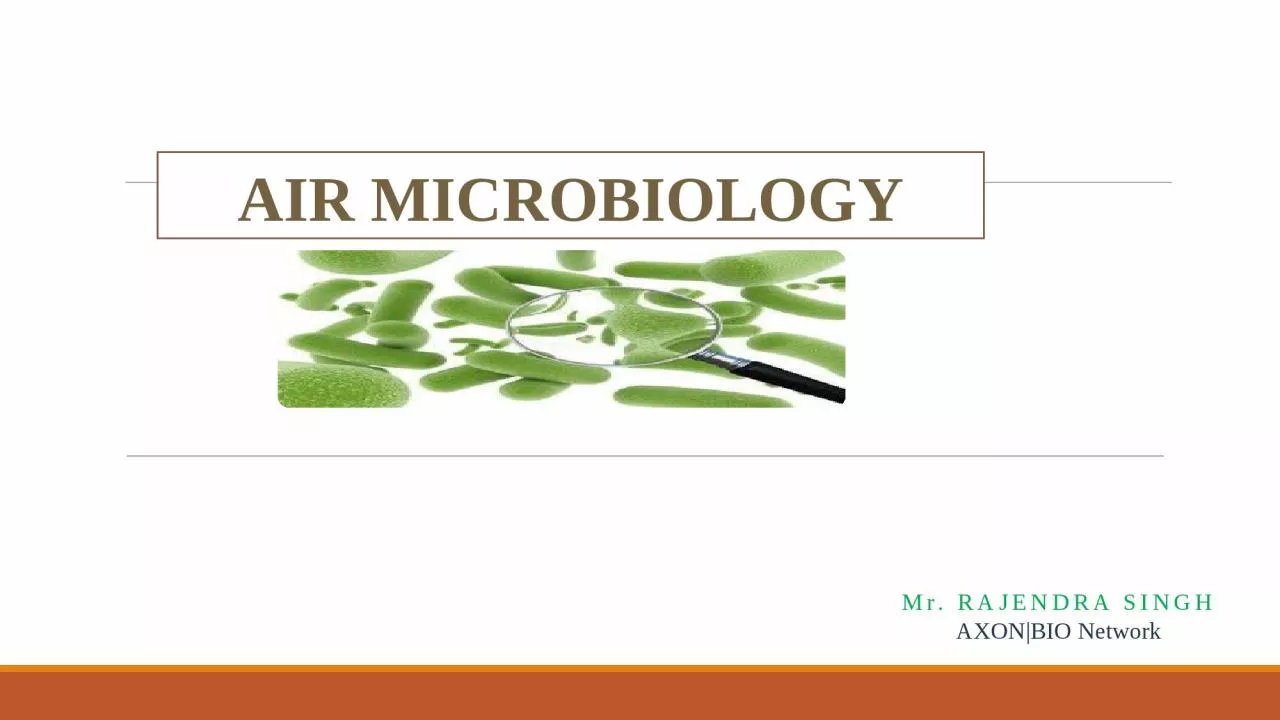

SINGH AXONBIO Network Contents Introduction Disease caused by air borne microbes Bacterial diseases Air born fungal diseases Air born viral diseases ID: 1040755
Download Presentation The PPT/PDF document "AIR MICROBIOLOGY Mr. RAJENDRA" is the property of its rightful owner. Permission is granted to download and print the materials on this web site for personal, non-commercial use only, and to display it on your personal computer provided you do not modify the materials and that you retain all copyright notices contained in the materials. By downloading content from our website, you accept the terms of this agreement.
1. AIR MICROBIOLOGYMr. RAJENDRA SINGH AXON|BIO Network
2. Contents –Introduction Disease caused by air borne microbes - Bacterial diseases - Air born fungal diseases - Air born viral diseases3. Sources of microorganism in air4. Microbes in atmosphere5. Outdoor aero microbiology 6. Indoor aero microbiologyFactors affecting microbial survival in air8. Significance of microorganism in air 9. References
3. AERO-MICROBIOLOGYAerobiology is defined as the study of life present in the air.Aero-microbiology relates to the study of environmentally relevant microorganisms.
4. 2. Disease caused by air borne microbesBacterial diseases –Brucellosis: Brucella-suis it is mainly an occupational disease among veterinarian, butcher and slaughter house workers.
5. Pulmonary Anthrax: Anthrax is caused by a spore-forming bacterium. It mainly affects animals. Humans can become infected through contact with an infected animal or by inhaling spores.
6. Air Borne Fungal DiseasesBlastomycosis: Blastomycosis is an infection caused by the fungus Blastomyces. The fungus lives in the environment, particularly in moist soil and in decomposing organic matter such as wood and leaves.
7. Aspergillosis: Aspergillosis is an infection caused by Aspergillus, a common mold (a type of fungus) that lives indoors and outdoors. Infection occurs through inhalation of spores. Most people breathe in Aspergillus spores every day without getting sick.
8. Air Borne Viral DiseasesCommon Cold: Most people get colds in the winter and spring, but it is possible to get a cold any time of the year. Symptoms usually include sore throat, runny nose, coughing, sneezing, watery eyes, headaches and body aches. Most people recover within about 7-10 days.
9. Influenza: Symptoms of influenza are nasal discharge, head ache, muscle pains, sore throat and general weakness. Causative agents are orthomyxovirus.
10. 3. Source of Microorganism in Air
11. 4. Microbes in AtmosphereThe atmospheric layers and the airflow pattern are the important forces in determining the distribution and dynamics of viable particles in air. The aero microbiological pathway (AMP) involves the path and pattern of movement of microbial particles in atmosphere.The layer of most interest and significance in aero microbiological is the boundary layer, which extends up to 0.1km form the earth’s surface.
12. 5. Outdoor Aero MicrobiologyAirborne crop pathogen: Bio-aerosol are of direct relevance to agriculture. Air borne microbial pathogens are responsible for a large range of important disease of crop plants.Waste disposal: A range of pathogenic microbes, viruses-bacteria, protozoa and helminthes associates with waste effluents bring about health hazard during their treatment and disposal handling.
13. 6. Indoor Aero MicrobiologyPrivate homes and office building: Extent of bio-aerosols development determines the health of any building. These include several factors that influence the formation of bio-aerosols.Hospital and Laboratories: These two indoor environments have such potential for the aero-solisation of pathogenic microbes. Microbiological laboratories are also a breeding center for pathogenic microbes.Space flight: Microbes have been detected even from harsh environments. They are associated with every aspect of life even space craft.
14. 7. Factors affecting microbial survival in air Atmospheric humidity: The relative as well as the absolute humidity content of the air play a major role in the survival of the air borne microorganism.Temperature: Temperature is the major factor in the inactivation of microbes. High temperature promotes inactivation, mainly associated with desiccation and protein denaturation and lower temperature promotes longer survival times.
15. 8. Control of microorganism in airUltraviolet Radiation • This method has great potential value for reducing the microbial flora of air. • It is done by following ways : 1. Direct irradiation. e.g. aseptic filling rooms for pharmaceutical preparations 2. Indirect Irradiation. e.g. occupied rooms, offices, wards etc.
16. Chemical Agents• Chemical substances vaporized into air of room are effective in reducing the microbial flora.• Chemicals are dispersed as aerosol and show its anti microbial action.• Characteristics of chemical agent as germicide: • It should be highly bactericidal.LAMINAR AIR FLOW SYSTEMS • Air passes through HIGHER EFFICACYPARTICULATE AIR (HEPA) filters. • Operation. • Application. • Natural or mechanical ventilation of rooms.
17. 9. Significance of Microorganisms in AirFood manufacture:Spoilage of foods and fermentation products:
18. References –Microbiology- Prescott, Harley & Klein’s. 7th Edition. Published by Mc Graw-Hill.Environmental microbiology, 2008- Pradipta k. mohapatra, I.K. international publications pvt. Ltd.Environmental microbiology, 2005- P D sharma.WWW. Google.co.in/picture
19. THANKYOU